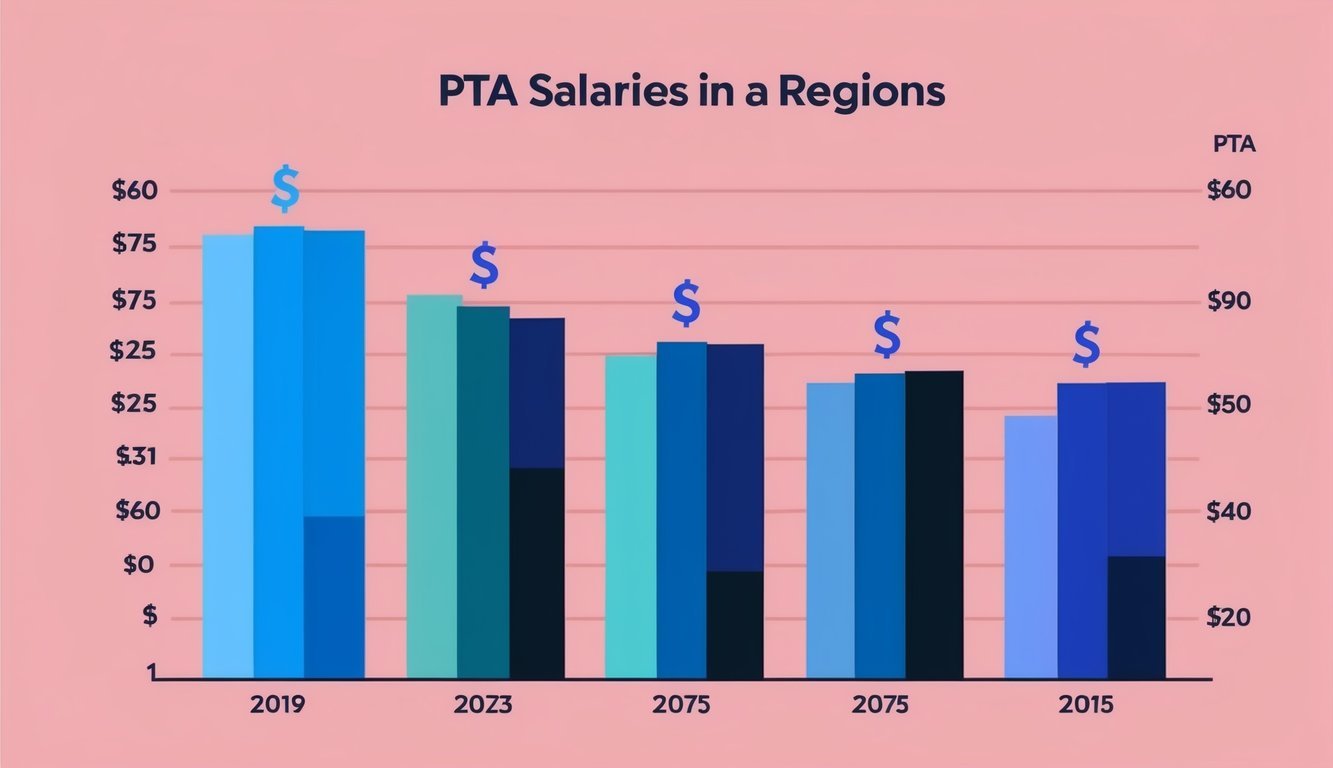If you’re exploring a career as a physical therapist assistant (PTA) within the allied healthcare field, you might wonder about the financial rewards this profession offers. The United States has an average annual salary for PTAs of approximately $57,240, translating to an hourly wage of about $27.52. These figures can vary significantly based on factors such as location, experience, and the type of healthcare facility in which you work.
In your research, you may find that some states offer higher salaries than others, influenced by the cost of living and demand for healthcare services.
For instance, certain metropolitan areas are known for attractive PTA salaries, making them appealing locations for job seekers.
Websites like Nurse.org and Indeed provide valuable insights into regional salary variations and job prospects, which can help you make informed decisions about your career path.
Understanding the earning potential in this role is essential as you consider your future in healthcare.
With the right education and commitment, a career as a PTA not only offers the chance to make a difference in patients’ lives but also provides a solid financial foundation within the allied healthcare profession.
Overview of PTA as a Profession
The role of a Physical Therapist Assistant (PTA) is integral to the delivery of physical therapy services.
PTAs support physical therapists in rehabilitating patients and play a vital role in assisting with therapies.
Understanding the licensure, certification, education, and training required for this profession is essential for aspiring PTAs.
Role and Responsibilities
As a PTA, you assist physical therapists in implementing treatment plans and providing rehabilitation services.
Your duties may include:
- Administering exercises: You implement therapeutic exercises designed by a physical therapist to help patients recover mobility and strength.
- Monitoring patient progress: You track how patients respond to treatment and communicate progress to the supervising physical therapist.
- Maintaining equipment: You ensure that all therapeutic equipment is clean and functioning properly for each patient.
You may work in various settings, including hospitals, outpatient clinics, and rehabilitation centers.
Approximately 72% of PTAs work in hospitals or private practices, allowing you to gain diverse experience in physical therapy environments.
Licensure and Certification Requirements
To practice as a PTA, you must obtain licensure in your state.
This often involves passing a national examination administered by the Federation of State Boards of Physical Therapy.
Each state has its specific regulations and licensing requirements, so you should check local laws for more information.
Many employers also prefer certification from the American Physical Therapy Association (APTA).
This can enhance job prospects and credibility in the field.
Education and Training
Typically, you will need an associate degree from an accredited physical therapist assistant program.
These programs include both coursework and hands-on clinical experience.
Key components of your education will include:
- Human anatomy and physiology
- Kinesiology
- Rehabilitation techniques
- Clinical practice
Upon completion of the program, you will develop a solid foundation in providing patient care and therapeutic interventions.
Practicing as a PTA can lead to opportunities for further education and specialization, enhancing your career in physical therapy.
Compensation Structures for PTAs
Understanding the compensation structures for Physical Therapist Assistants (PTAs) is essential for anyone considering a career in this field.
The salary can vary based on several factors, including geographic location, experience, and specific job settings.
Understanding PTA Salary
The average salary for a Physical Therapist Assistant typically ranges from $55,761 to $65,860 annually, depending on the source.
The median pay reported by the U.S. Bureau of Labor Statistics is approximately $57,240 per year.
Most PTAs earn an hourly wage of $26.80 to $31.01, with the potential to make more in particular regions or healthcare settings.
| Salary Category | Average Annual Salary | Hourly Wage |
|---|---|---|
| Average PTA Salary | $64,510 | $31.01 |
| Median PTA Salary | $57,240 | $27.52 |
| Bottom 25% | $53,970 | $25.94 |
| Top 10% | $85,230 | $40.94 |
For detailed salary information by state, you can refer to resources like PTA Salaries by State.
Factors Influencing Salary
Several factors influence your salary as a PTA.
Geographic location plays a significant role; states with a higher cost of living tend to offer higher wages.
For example, jobs in metropolitan areas may provide better compensation compared to rural settings.
Your experience level and certification status also impact your earnings.
PTAs with specialized certifications often earn higher salaries.
Additionally, flexibility in work settings, such as clinics, hospitals, or home health agencies, can present differing pay scales.
Other variables such as job demand, employer type, and benefits can also affect overall compensation.
It’s crucial to consider these aspects when evaluating job offers and potential career paths in healthcare jobs.
Geographical Variations in PTA Salary

Understanding how geographical location affects the salary of physical therapist assistants (PTAs) can help you make informed career decisions.
Different states and cities exhibit notable variations in pay, influenced by factors like cost of living, demand for PTAs, and local healthcare regulations.
Salary by State and City
In the United States, PTA salaries vary significantly by state and city.
According to the Bureau of Labor Statistics, states like California and New York often offer the highest average salaries due to their high cost of living and significant demand for healthcare services.
Here’s a brief overview of average salary ranges in select states:
| State | Average Salary |
|---|---|
| California | $78,000 |
| New York | $75,000 |
| Texas | $65,000 |
| Florida | $60,000 |
| Ohio | $58,000 |
Major cities also exhibit disparities.
For example, PTAs in metropolitan areas like Los Angeles and San Francisco typically earn more compared to those in rural settings.
Job availability and industry growth further influence these salary differences.
Understanding these geographical factors allows you to evaluate potential job markets effectively and make salary expectations grounded in your location.
For detailed insights on PTA pay, consult resources like the Bureau of Labor Statistics.
Advancement and Specialization Opportunities

As you navigate your career as a Physical Therapist Assistant (PTA), there are numerous pathways for advancement and specialization that can enhance your professional growth and increase your earning potential.
Understanding these opportunities can help you make informed decisions about your career trajectory.
Career Progression for PTAs
As a PTA, your career can advance in several ways.
Obtaining additional certifications or completing a Doctor of Physical Therapy (DPT) program can significantly increase your responsibilities and potential salary.
For instance, PTAs who pursue a DPT may transition into roles such as physical therapist, leading to a substantial salary increase.
Here is a simplified table outlining the potential career advancements and their associated average salaries:
| Position | Average Salary |
|---|---|
| Physical Therapist Assistant | $64,510 |
| Physical Therapist | $85,000 – $100,000 |
| Clinic Director | $90,000 – $120,000 |
Additionally, traveling PTAs often receive higher compensations due to the demand for their services in various locations.
They can earn between $70,000 and $90,000 annually, along with benefits like housing allowances.
Specializing as a PTA
Specialization allows PTAs to develop expertise in specific areas of physical therapy, thus enhancing job marketability.
Certification programs are available in fields such as geriatrics, orthopedics, and sports therapy.
To specialize, you may consider joining the APTA’s Advanced Proficiency Pathways program, which recognizes your advanced skills and knowledge.
By specializing, you can command a higher salary, with some PTAs earning up to $85,230 annually, depending on their focus area and level of experience.
Opting for specialization not only improves your earning potential but also contributes to better patient care outcomes, making you a valuable member of any healthcare team.
Current Trends and Future Outlook

The demand for physical therapy assistants (PTAs) is increasing significantly.
According to the Bureau of Labor Statistics, employment for PTAs is projected to grow by 24% from 2018 to 2028.
This trend reflects the rising need for rehabilitation services in various healthcare settings.
Salary Insights
The average annual salary for PTAs varies by location and experience level.
The following table summarizes key salary data:
| Salary Percentile | Annual Salary | Hourly Wage |
|---|---|---|
| Bottom 25% | $53,970 | $25.93 |
| Median | $64,510 | $31.01 |
| Top 10% | $85,230 | $40.98 |
In 2024, the average salary is expected to increase to $83,170, with Dallas, TX leading at an average of $105,156 per year.
Industry Growth
The healthcare sector is experiencing robust growth, with a significant shift towards home health care services.
This segment is projected to see job growth of 47%, reflecting changing patient preferences and demographics.
You can refer to the full Bureau of Labor Statistics report for more detailed insights on employment projections for PTAs.
As you look ahead, consider the benefits of pursuing a career in this field, given the strong job outlook and competitive salaries.

